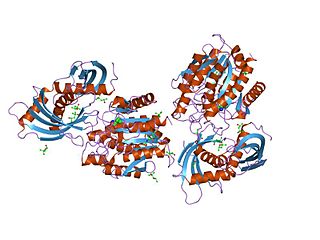
The retinoids are a class of chemical compounds that are vitamers of vitamin A or are chemically related to it. Retinoids have found use in medicine where they regulate epithelial cell growth.

Tazarotene, sold under the brand name Tazorac, among others, is a third-generation prescription topical retinoid. It is primarily used for the treatment of plaque psoriasis and acne. Tazarotene is also used as a therapeutic for photoaged and photodamaged skin. Tazarotene is a member of the acetylenic class of retinoids.
The retinoic acid receptor (RAR) is a type of nuclear receptor which can also act as a ligand-activated transcription factor that is activated by both all-trans retinoic acid and 9-cis retinoic acid, retinoid active derivatives of Vitamin A. They are typically found within the nucleus. There are three retinoic acid receptors (RAR), RAR-alpha, RAR-beta, and RAR-gamma, encoded by the RARA, RARB, RARG genes, respectively. Within each RAR subtype there are various isoforms differing in their N-terminal region A. Multiple splice variants have been identified in human RARs: four for RARA, five for RARB, and two for RARG. As with other type II nuclear receptors, RAR heterodimerizes with RXR and in the absence of ligand, the RAR/RXR dimer binds to hormone response elements known as retinoic acid response elements (RAREs) complexed with corepressor protein. Binding of agonist ligands to RAR results in dissociation of corepressor and recruitment of coactivator protein that, in turn, promotes transcription of the downstream target gene into mRNA and eventually protein. In addition, the expression of RAR genes is under epigenetic regulation by promoter methylation. Both the length and magnitude of the retinoid response is dependent of the degradation of RARs and RXRs through the ubiquitin-proteasome. This degradation can lead to elongation of the DNA transcription through disruption of the initiation complex or to end the response to facilitate further transcriptional programs. Due to RAR/RXR heterodimers acting as subtrates to the non steroid hormone ligand retinoid they are extensively involved in cell differentiation, proliferation, and apoptosis.

The nuclear receptor 4A1 also known as Nur77, TR3, and NGFI-B is a protein that in humans is encoded by the NR4A1 gene.

Retinoid X receptor alpha (RXR-alpha), also known as NR2B1 is a nuclear receptor that in humans is encoded by the RXRA gene.

Retinoic acid receptor alpha (RAR-α), also known as NR1B1 is a nuclear receptor that in humans is encoded by the RARA gene.

RIG-I is a cytosolic pattern recognition receptor (PRR) that can mediate induction of a type-I interferon (IFN1) response. RIG-I is an essential molecule in the innate immune system for recognizing cells that have been infected with a virus. These viruses can include West Nile virus, Japanese Encephalitis virus, influenza A, Sendai virus, flavivirus, and coronaviruses.

Retinoid X receptor beta (RXR-beta), also known as NR2B2 is a nuclear receptor that in humans is encoded by the RXRB gene.

Retinoic acid receptor gamma (RAR-γ), also known as NR1B3 is a nuclear receptor encoded by the RARG gene. Adapalene selectively targets retinoic acid receptor beta and retinoic acid receptor gamma and its agonism of the gamma subtype is largely responsible for adapalene's observed effects.

G protein-coupled receptor 56 also known as TM7XN1 is a protein encoded by the ADGRG1 gene. GPR56 is a member of the adhesion GPCR family. Adhesion GPCRs are characterized by an extended extracellular region often possessing N-terminal protein modules that is linked to a TM7 region via a domain known as the GPCR-Autoproteolysis INducing (GAIN) domain.

Protein kinase C eta type is an enzyme that in humans is encoded by the PRKCH gene.

Decoy receptor 2 (DCR2), also known as TRAIL receptor 4 (TRAILR4) and tumor necrosis factor receptor superfamily member 10D (TNFRSF10D), is a human cell surface receptor of the TNF-receptor superfamily.

Retinol binding protein 1, cellular, also known as RBP1, is a protein that in humans is encoded by the RBP1 gene.

Cellular retinoic acid-binding protein 1 is a protein that in humans is encoded by the CRABP1 gene.

OX-2 membrane glycoprotein, also named CD200 is a human protein encoded by the CD200 gene. CD200 gene is in human located on chromosome 3 in proximity to genes encoding other B7 proteins CD80/CD86. In mice CD200 gene is on chromosome 16.

Large tumor suppressor kinase 2 (LATS2) is an enzyme that in humans is encoded by the LATS2 gene.

Retinoic acid receptor responder protein 1 is a protein that in humans is encoded by the RARRES1 gene.

RING finger protein 135 is a protein that in humans is encoded by the RNF135 gene.

Chemerin, also known as retinoic acid receptor responder protein 2 (RARRES2), tazarotene-induced gene 2 protein (TIG2), or RAR-responsive protein TIG2 is a protein that in humans is encoded by the RARRES2 gene.

In molecular biology, the latexin family is a family of proteins which family consists of several animal specific latexin and proteins related to latexin that belong to MEROPS proteinase inhibitor family I47, clan IH.




















